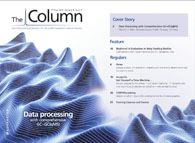Restoration art
A group of researchers has conducted an investigation into the degradation process of proteinaceous binders due to ultra violet (UV) light in old works of art.

A group of researchers has conducted an investigation into the degradation process of proteinaceous binders due to ultra violet (UV) light in old works of art.1 The impact of this investigation for conservation and restoration efforts is considerable.
Three different medieval paint model samples were prepared according to original recipes, using rabbit glue as proteinaceous binders. One sample contained only the binder, while the other two were prepared by mixing each of the pigments (cinnabar or azurite) with the binder (glue temera model samples).
The samples were aged over 3000 h of UV radiation and were analysed every 200 h to mark the progression of the study. The samples were studied by applying principal component analysis (PCA) on matrix‑assisted laser desorption/ionization-time of flight mass spectrometry (MALDI-TOF-MS). The team noted significant changes in the samples and the results suggested different ageing behaviour based on the pigment present.
The team concluded that this first study of PCA on MALDI-TOF-MS can assist in the future restoration of works of art.
1. C. Cardell et al.,Journal of Mass Spectrometry, 47(3), 322–330 (2012).
This story originally appeared in The Column. Click here to view that issue.
Removing Double-Stranded RNA Impurities Using Chromatography
April 8th 2025Researchers from Agency for Science, Technology and Research in Singapore recently published a review article exploring how chromatography can be used to remove double-stranded RNA impurities during mRNA therapeutics production.
The Effect of Time and Tide On PFAS Concentrations in Estuaries
April 8th 2025Oliver Jones and Navneet Singh from RMIT University, Melbourne, Australia discuss a recent study they conducted to investigate the relationship between tidal cycles and PFAS concentrations in estuarine systems, and offer practical advice on the sample preparation and LC–MS/MS techniques they used to achieve the best results.











